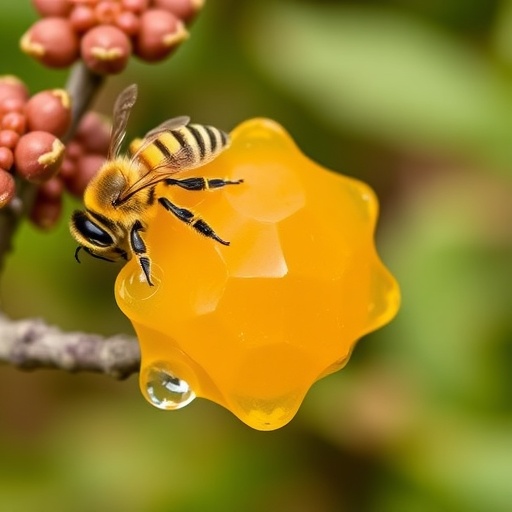Recent research published in the Environmental Science and Pollution Research journal sheds light on the protective properties of royal jelly against arsenic toxicity, particularly its effects on rat liver health. This study, conducted by Kaya, Şimşek, Ulucan, and others, explores a significant environmental concern: arsenic exposure, which poses serious health risks to humans and animals alike. As a naturally occurring element, arsenic is notorious for its toxicity and potential to cause various diseases, particularly affecting the liver, a vital organ responsible for detoxification and metabolic processes.
Historically, arsenic has been leveraged in various industries, resulting in environmental contamination that continues to affect populations worldwide. Individuals can be exposed to arsenic through contaminated water, air, and food, prompting researchers to seek viable solutions for reducing its detrimental effects. The study’s focus on royal jelly, a nutritious substance produced by bees, highlights an innovative approach to combatting the adverse effects of arsenic in biological systems.
Royal jelly is rich in bioactive compounds, including proteins, lipids, and carbohydrates, which may contribute to its therapeutic properties. Its composition offers a myriad of health benefits, such as anti-inflammatory, antioxidant, and immunomodulatory effects. These attributes make royal jelly an interesting candidate for research into natural protective agents against toxins like sodium arsenite, a common form of arsenic used in laboratory studies when assessing toxicity.
The researchers aimed to assess the extent to which royal jelly could mitigate the effects of sodium arsenite on rat liver function and overall health. By administering different doses of royal jelly to experimental rats exposed to sodium arsenite, the team meticulously monitored various liver parameters, including enzyme levels and histopathological changes. Through their experiments, they aimed to discern whether royal jelly could reduce oxidative stress, a primary mechanism by which arsenic induces toxicity in liver cells.
In this context, oxidative stress occurs when there’s an imbalance between free radicals and antioxidants in the body. Arsenic compounds can significantly elevate oxidative stress levels, leading to cellular damage. The roles of antioxidants, like those found in royal jelly, are pivotal in mitigating this damage and restoring cellular health. The comforting notion is that harnessing nature’s remedies, such as bee products, can offer promising avenues for therapeutic intervention in arsenic-induced toxicity.
The study’s findings revealed that royal jelly exhibited a protective effect on liver tissues, evidenced by decreased levels of liver enzymes typically elevated in cases of toxic injury. Specifically, enzymes like AST (aspartate aminotransferase) and ALT (alanine aminotransferase) were significantly lower in rats treated with royal jelly compared to those exposed solely to sodium arsenite. These results are crucial because elevated enzyme levels often indicate liver damage and dysfunction, highlighting the potential of royal jelly in preserving liver health under toxic conditions.
Intriguingly, further histological assessment of liver tissues showed that royal jelly not only shielded the liver from damage caused by sodium arsenite but also appeared to promote cellular regeneration. This regenerative property is essential, as it suggests that royal jelly may not only provide short-term protective effects but long-term benefits, encompassing liver recovery from toxic insults. This regenerative approach supports the broader concept of using natural products in the development of therapeutic strategies against environmental toxins.
The implications of this research extend beyond the confines of laboratory settings. Given the worldwide prevalence of arsenic-contaminated environments, especially in regions relying on groundwater for drinking and irrigation, the potential application of royal jelly as a dietary supplement could have significant public health benefits. It raises an important question about the integration of natural products into our daily lives as a proactive measure against environmental toxins.
Moreover, the study underscores the importance of interdisciplinary research that bridges the fields of ecology, toxicology, and nutrition. By understanding how traditional remedies can interact with modern approaches to medicine, we create a comprehensive framework in tackling global hazards such as arsenic exposure. This research exemplifies the necessity of reevaluating natural compounds not merely as adjuncts but as pivotal players in health science.
As we navigate the complexities of environmental pollution, the research provides hope that natural substances may act as effective shields against toxins lurking in our ecosystems. The exploration of royal jelly in this context serves as a promising example of how nature may hold the key to safeguarding health despite the challenges posed by a toxic world.
Significantly, there is also an exciting opportunity for follow-up studies, especially in human clinical trials, to examine the translational potential of royal jelly as a protective agent against hepatic toxicity induced by arsenic exposure. Understanding dosage, timing, and the mode of delivery of royal jelly are critical next steps in elucidating its efficacy and practical applications.
The findings of the study undeniably pave the way for new research pathways, evaluating the broader implications of incorporating natural products into preventive medicine against the backdrop of rising environmental toxicology concerns. The valuable knowledge derived from such studies can eventually lead to innovative strategies that harness the power of nature to combat health risks associated with environmental pollutants.
In conclusion, the groundbreaking research by Kaya and colleagues serves as a testament to the resilience of nature and the importance of exploring its resources in the face of modern-day challenges. It invites further inquiry into the profound relationships between environmental health and natural remediation strategies, reinforcing the idea that solutions to our most pressing health issues may lie within the vast, uncharted territories of the natural world.
Subject of Research: The protective properties of royal jelly against arsenic toxicity in rat liver.
Article Title: Natural shield against arsenic threat: potential of royal jelly to protect rat liver against sodium arsenite toxicity.
Article References:
Kaya, E., Şimşek, H., Ulucan, A. et al. Natural shield against arsenic threat: potential of royal jelly to protect rat liver against sodium arsenite toxicity.
Environ Sci Pollut Res (2025). https://doi.org/10.1007/s11356-025-36974-4
Image Credits: AI Generated
DOI:
Keywords: Royal jelly, arsenic toxicity, liver protection, oxidative stress, natural remedies.




